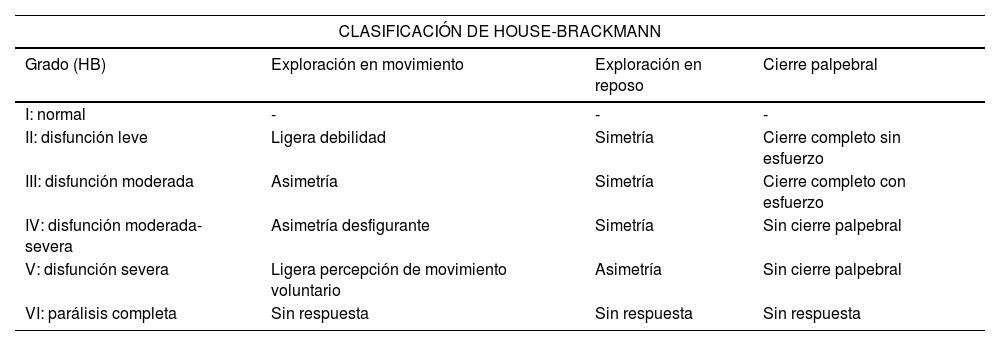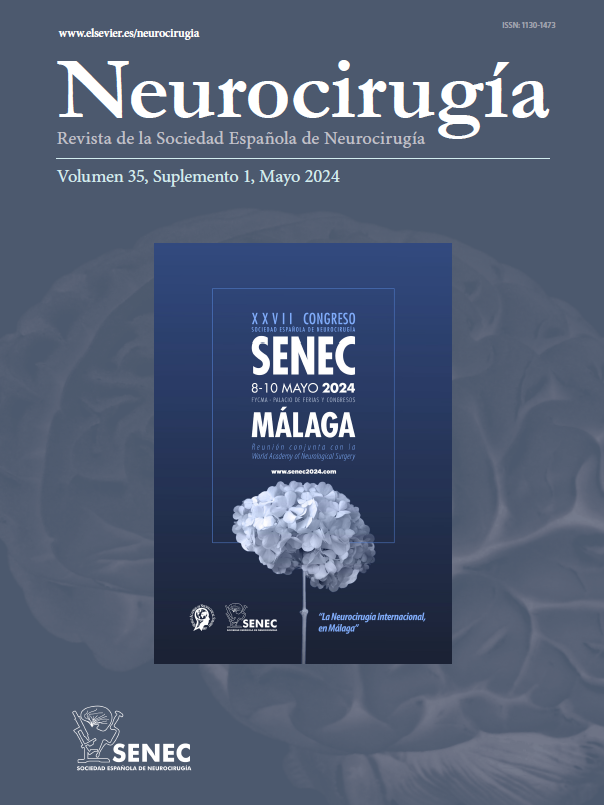La monitorización neurofisiológica intraoperatoria permite predecir la situación funcional del nervio facial tras la cirugía de schwannoma vestibular. Dada la gran variabilidad de los protocolos neurofisiológicos utilizados para ello, el objetivo del presente estudio es determinar la capacidad pronóstica del protocolo neurofisiológico usado en nuestro servicio.
Material y métodosSe realizó un análisis estadístico de los datos de monitorización neurofisiológica recogidos en los pacientes intervenidos entre marzo de 2009 y julio de 2021 en el Servicio de Neurocirugía de Salamanca según su situación funcional, tanto en el período posquirúrgico inmediato como al año de la cirugía.
ResultadosSe analizó a 51 pacientes de entre 46 y 63 años (mediana: 54). Al estudiar el valor umbral de la intensidad de estimulación del nervio facial y la variación de los potenciales motores evocados córtico-bulbares, se hallaron diferencias significativas (p=0,043 y p=0,011, respectivamente) entre los pacientes con buena y mala situación clínica tras la cirugía. El valor umbral de intensidad más discriminativo fue 0,35mA (sensibilidad: 85%; especificidad: 48%). No se halló relación estadística en el grupo de estudio al año de la cirugía.
ConclusionesEl protocolo de monitorización intraoperatoria utilizado nos permite predecir la situación clínica de los pacientes en el período posquirúrgico inmediato y mejorar la información al paciente y sus familiares tras la intervención. No podemos, en cambio, utilizar estos parámetros para la predicción de la situación funcional al año de la cirugía ni para la toma de decisiones clínicas al respecto.
Intraoperative neurophysiological monitoring allows us to predict the functional status of the facial nerve after vestibular schwannoma surgery. Due to the great variability of the neurophysiological protocols used for it, the goal of this study is to determine the prognostic ability of our neurophysiological protocol.
Material and methodsWe have performed a statistical analysis of the neurophysiological monitoring data collected from patients operated between March 2009 and July 2021 at the Neurosurgery Service of Salamanca according to their functional status, both in the immediate post-surgical period and one year after surgery.
ResultsA number of 51 patients between 46 and 63 years old (median: 54) were analyzed. We have found significant differences studying the threshold value of the stimulation intensity of the facial nerve and the variation of the Cortico-bulbar Evoked Motor Potentials (P=0.043 and P=0.011, respectively) between the patients with good and bad clinical situation after surgery. The most discriminating intensity threshold value was 0.35mA (Sensitivity: 85%; Specificity: 48%). No statistical relationship was found in the study group one year after surgery.
ConclusionsOur intraoperative monitoring protocol allows us to predict the clinical situation of patients in the immediate postoperative period and improve information for the patient and her relatives after surgery. We cannot, however, use these parameters to predict the functional situation one year after surgery and make clinical decisions in this regard.
Article

If it is the first time you have accessed you can obtain your credentials by contacting Elsevier Spain in suscripciones@elsevier.com or by calling our Customer Service at902 88 87 40 if you are calling from Spain or at +34 932 418 800 (from 9 to 18h., GMT + 1) if you are calling outside of Spain.
If you already have your login data, please click here .
If you have forgotten your password you can you can recover it by clicking here and selecting the option ¿I have forgotten my password¿.














